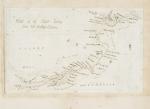Tuckey, Vintage, 19th century manuscript map "Chart of the River Zaire from Capt
Vintage, 19th century manuscript map “Chart of the River Zaire from Capt. Tuckeys Narrative”.
Ink on Paper. Britain, c. 1850. 18.4 cm wide x 11.3 cm high. Mounted on paper (partially detached). Mounted on paper with an additional manuscript map of East Tartary. These maps were drawn in a 19th-century hand and used to be part of a Sammelband of Maps in the Public Library of South Shields.
James Hingston Tuckey (August 1776 – 4 October 1816) was an Irish-born British explorer and a captain in the Royal Navy. Some sources mistakenly refer to him as James Kingston Tuckey.
Tuckey was born at Greenhill, near Mallow, August 1776. He went to sea at an early age, and in 1793 was received into the navy. From the first he saw a good deal of active service, and he was more than once wounded. He was engaged in expeditions to the Red Sea, and in 1802 he helped expand the British colony of New South Wales in Australia as first-lieutenant of the Calcutta. Amongst other services, he made a survey of Port Phillip District. On his return to England he published an Account of the Voyage to establish a Colony at Port Phillip. The Calcutta was captured by the French on a voyage from St. Helena in 1805, and Lieutenant Tuckey suffered an imprisonment of nearly nine years in France, during which time he married Miss Margaret Stuart, a fellow prisoner, and prepared a work on Maritime Geography and Statistics, published after his release.
In 1814 he was promoted to the rank of commander, and in February 1816 he sailed to explore the River Congo in the schooner Congo, accompanied by the stores ship Dorothy. The expedition aimed to find if there was a connection between the Congo and Niger basins of western and central Africa. Tuckey sailed up the river from its mouth but found that the lower river is not navigable due to rapids (later called the Yellala Falls) above Matadi, 160 km (99 mi) from the sea. He only found ruins of the Portuguese colony and moribund Catholic missions. He suggested sending Protestant missionaries to the Congo. He explored the river up to 480 km (298 mi) from the sea. Most of the officers and crew died of fever and Tuckey himself died on 14 October 1816, aged 40, in Moanda, on the coast of today’s DR Congo. The expedition was a failure but raised interest in the exploration of Africa.
Tuckey was described as tall, and had been handsome, but long and arduous service broke down his constitution, and by thirty he was grey-haired and nearly bald. Further it is described that his countenance was pleasing and pensive; he was gentle and kind in his manners, cheerful in conversation, and indulgent to those under his command. (Wikipedia)
- Keywords: 19.Jahrhundert · 19th Century · 19th Century Map · Africa · British Explorer · Cartography · Catalogue No.5 – Maps of the World · Congo · Expedition · Expeditions – Rare · Irish Explorer · Library & Collection Building · Mallow · Manuscript Map · Original Map · Original Maps · Rare Manuscript Map · Rare Map Africa · Rare Maps Collection – Africa · Vintage Map · Zaire
- Inventory Number: 408AG
© 2025 Inanna Rare Books Ltd. | Powered by HESCOM-Software











